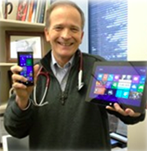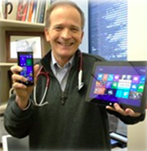

As a physician and one of the more visible members of our health industry team at Microsoft, I frequently find myself as the first point of contact for people who want to work with our company. In some cases this is other clinicians or developers looking for a job. More commonly, I get e-mail or calls from someone wanting to partner with Microsoft. The conversation often goes something like this:
“Hello, this is doctor so and so. I have just invented the world’s best, most fantastic new electronic medical record solution ever…” That’s about all it takes before my eyes start to glaze  over. How many times have I heard this before? Doesn’t this person know that there are hundreds if not thousands of EMR solutions already on the market? Do they have any idea how hard it is to break into that market? Can they even fathom the competition or how much money they will need to sustain this as a business? Some very big, multinational companies have gone down that road and backed away. Why does this person think they can succeed when so many others haven’t!
over. How many times have I heard this before? Doesn’t this person know that there are hundreds if not thousands of EMR solutions already on the market? Do they have any idea how hard it is to break into that market? Can they even fathom the competition or how much money they will need to sustain this as a business? Some very big, multinational companies have gone down that road and backed away. Why does this person think they can succeed when so many others haven’t!
I try to be polite and point out the obvious while not totally discouraging the dream. When I can, I point to developer resources that might be of help or to potential partners working on similar projects. I also point out that Microsoft is not directly in the electronic health records business. We went down that path a few years ago and found that it wasn’t a good fit for the company, with the exception of our consumer health platform, HealthVault. Instead, we collaborate with thousands of partners around the world who use our technologies in the solutions they build, including electronic health records, for institutions and practices large and small.
 HealthcareITNews reports that the federal government has now dispensed some $13.7 Billion to hospitals and clinicians who have attested to the “meaningful use” incentive program. 87 percent of eligible hospitals and about half of all physicians have signed up for the program thus far. While that is encouraging, HealthcareITNews also states that Farzad Mostashari, MD, the national coordinator for health IT, has stated that the industry is about halfway toward digitizing the healthcare system and 5 percent of the way toward reaping the benefits of that IT infrastructure. Scaling that success, practice-by-practice and not just among large health systems is going to the challenge moving forward . In other words, we have a long way to go and it seems to me the feds will run out of enthusiasm, money or both before we get there.
HealthcareITNews reports that the federal government has now dispensed some $13.7 Billion to hospitals and clinicians who have attested to the “meaningful use” incentive program. 87 percent of eligible hospitals and about half of all physicians have signed up for the program thus far. While that is encouraging, HealthcareITNews also states that Farzad Mostashari, MD, the national coordinator for health IT, has stated that the industry is about halfway toward digitizing the healthcare system and 5 percent of the way toward reaping the benefits of that IT infrastructure. Scaling that success, practice-by-practice and not just among large health systems is going to the challenge moving forward . In other words, we have a long way to go and it seems to me the feds will run out of enthusiasm, money or both before we get there.

That has me re-evaluating my stance that the last thing the world needs is another electronic medical record solution—that all the innovation has already been done. Yesterday, on this blog I described what some of the best minds in the country (including Dr. John Halamka) believe the market is seeking. I think recent innovations in tech (cloud computing and storage, natural user interface, touch, the “internet of things”, big data, sensors, machine learning, apps everywhere, new devices and form factors, mobility, multi-media, etc.) have created new opportunities to re-imagine electronic health record solutions. Past generations of EHR/EMR solutions, often designed by engineers rather than clinicians, have relied too much on copying paper-based workflow. It’s time to rethink how we capture, analyze and share health information as well as who is best suited to perform each step of that workflow along the way. It’s time to admit that we have failed in our pursuit to develop the ideal solution or solutions, let alone solutions that are truly affordable at scale. I think we can do better.
So, the next time I get one of those calls, I promise not to roll my eyes quite so soon. If you are a developer, software engineer, or a clinician interested in improving health and healthcare by coming up with much improved EHR/EMR solutions, I hope you’ll stick to it. Also, be sure to check out some of the resources we’ve made available at www.microsoft.com/health and www.microsoft.com/health/ww.






